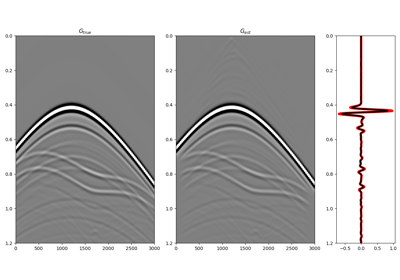pymarchenko.marchenko.Marchenko#
- class pymarchenko.marchenko.Marchenko(R, dt=0.004, nt=None, dr=1.0, nfmax=None, wav=None, toff=0.0, nsmooth=10, dtype='float64', saveRt=True, prescaled=False, isava=None, S=None)[source]#
Marchenko redatuming
Solve multi-dimensional Marchenko redatuming problem using
scipy.sparse.linalg.lsqriterative solver.- Parameters:
- R
numpy.ndarray Multi-dimensional reflection response in time or frequency domain of size \([n_s \times n_r \times n_t/n_{fmax}]\). If provided in time,
Rshould not be of complex type. If provided in frequency,Rshould contain the positive time axis followed by the negative one. Note that the reflection response should have already been multiplied by 2.- dt
float, optional Sampling of time integration axis
- nt
int, optional Number of samples in time (not required if
Ris in time)- dr
float, optional Sampling of receiver integration axis
- nfmax
int, optional Index of max frequency to include in deconvolution process
- wav
numpy.ndarray, optional Wavelet to apply to direct arrival when created using
trav- toff
float, optional Time-offset to apply to traveltime
- nsmooth
int, optional Number of samples of smoothing operator to apply to window
- dtype
bool, optional Type of elements in input array.
- saveRt
bool, optional Save
RandR^Hto speed up the computation of adjoint ofpylops.signalprocessing.Fredholm1(True) or createR^Hon-the-fly (False) Note thatsaveRt=Truewill be faster but double the amount of required memory- prescaled
bool, optional Apply scaling to
R(False) or not (False) when performing spatial and temporal summations within thepylops.waveeqprocessing.MDCoperator. In caseprescaled=True, theRis assumed to have been pre-scaled by the user.- isava
list, optional Indices of available sources. If not
None, apylops.Restrictionoperator is used instead of thepylops.Identityoperator along the main diagonal of the Marchenko operator- S
pylops.LinearOperator, optional Sparsifying transform to be provided to solve the Marchenko equations via the
pylops.optimization.sparsity.FISTAsolver in the case of missing sources. IfS=None, least-squares inversion is used instead.
- R
- Raises:
- TypeError
If
tis notnumpy.ndarray.
See also
MDCMulti-dimensional convolution
MDDMulti-dimensional deconvolution
Notes
Marchenko redatuming is a method that allows to produce correct subsurface-to-surface responses given the availability of a reflection data and a macro-velocity model [1].
The Marchenko equations can be written in a compact matrix form [2] and solved by means of iterative solvers such as LSQR:
\[\begin{split}\begin{bmatrix} \Theta \mathbf{R} \mathbf{f_d^+} \\ \mathbf{0} \end{bmatrix} = \mathbf{I} - \begin{bmatrix} \mathbf{0} & \Theta \mathbf{R} \\ \Theta \mathbf{R^*} & \mathbf{0} \end{bmatrix} \begin{bmatrix} \mathbf{f^-} \\ \mathbf{f_m^+} \end{bmatrix}\end{split}\]Subsequently the subsurface Green’s functions can be obtained applying the following operator to the retrieved focusing functions
\[\begin{split}\begin{bmatrix} -\mathbf{g^-} \\ \mathbf{g^{+ *}} \end{bmatrix} = \mathbf{I} - \begin{bmatrix} \mathbf{0} & \mathbf{R} \\ \mathbf{R^*} & \mathbf{0} \end{bmatrix} \begin{bmatrix} \mathbf{f^-} \\ \mathbf{f^+} \end{bmatrix}\end{split}\]Here \(\mathbf{R}\) is the monopole-to-particle velocity seismic response (already multiplied by 2).
Finally this routine can also be used to solve the Marchenko equations in the case of missing sources (provided that the available sources are co-located with receivers at indices
isava):\[\begin{split}\begin{bmatrix} \Theta \mathbf{R} \mathbf{f_d^+} \\ \mathbf{0} \end{bmatrix} = \begin{bmatrix} \mathbf{S} & \Theta \mathbf{R} \\ \Theta \mathbf{R^*} & \mathbf{S} \end{bmatrix} \begin{bmatrix} \mathbf{f^-} \\ \mathbf{f_m^+} \end{bmatrix}\end{split}\]where \(\mathbf{S}\) is a
pylops.Restrictionoperator. Note that in order to succesfully reconstruct focusing functions that do not present gaps at the location of missing sources, additional prior information must be provided in the form of sparsifying transforms and the equation must be solved via sparsity-promoting inversion. This is achieived by providing an appropriateSopoperator.[1]Wapenaar, K., Thorbecke, J., Van der Neut, J., Broggini, F., Slob, E., and Snieder, R., “Marchenko imaging”, Geophysics, vol. 79, pp. WA39-WA57. 2014.
[2]van der Neut, J., Vasconcelos, I., and Wapenaar, K. “On Green’s function retrieval by iterative substitution of the coupled Marchenko equations”, Geophysical Journal International, vol. 203, pp. 792-813. 2015.
[3]Haindl, C., Ravasi, M., and Broggini, F., K. “Handling gaps in acquisition geometries — Improving Marchenko-based imaging using sparsity-promoting inversion and joint inversion of time-lapse data”, Geophysics, vol. 86, pp. S143-S154. 2021.
- Attributes:
Methods
__init__(R[, dt, nt, dr, nfmax, wav, toff, ...])apply_multiplepoints(trav[, G0, nfft, rtm, ...])Marchenko redatuming for multiple points
apply_onepoint(trav[, G0, nfft, rtm, ...])Marchenko redatuming for one point

